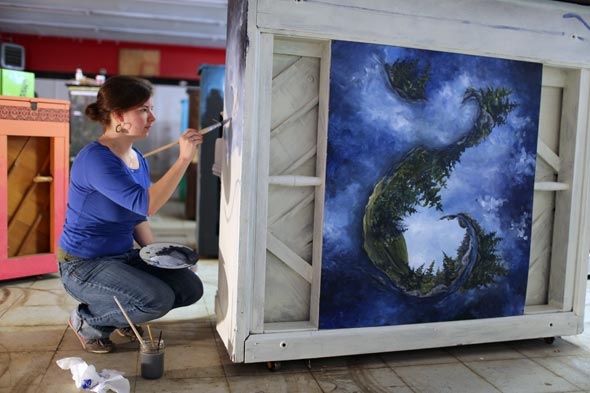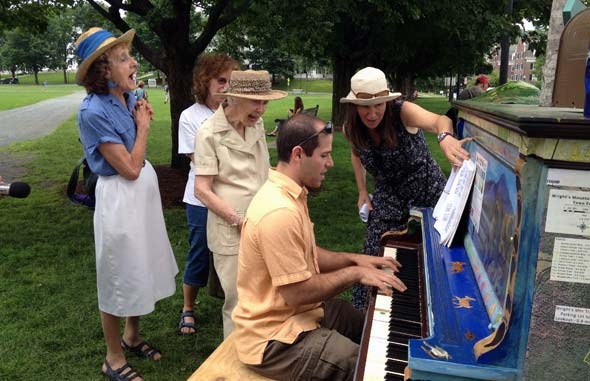Across from the musical chambers and recital halls of the Hopkins Center for the Arts (Hop), an impromptu group of community members put on their own performance on the Green. Every Thursday this month, young and old gather around a flamboyantly decorated piano singing Broadway show tunes, Beatles songs, and pop music, as part of the Hop’s “Lunchtime Sing-Alongs.”

Hands On Pianos artists, including Dartmouth graduate student Emily Burgess, worked together in a large warehouse, providing feedback and suggestions to each other as their projects developed. (photo by Rob Strong ’04)
The instrument on the Green is one of 50 used pianos placed throughout the Upper Valley in celebration of the Hop’s 50th anniversary. The project, Hands On Pianos, runs through July.
The undertaking started in March when the Hop partnered with the AVA Gallery and Arts Center in Lebanon, N.H., and accepted applications from donors and artists looking to contribute. Community members donated pianos to the Hop, which did maintenance and cleaning on the pianos to get them in playable shape. Stephanie Pacheco, outreach and arts education manager at the Hop, said workers found surprising things while cleaning inside the pianos, “everything from old animal nests to pennies over a hundred years old.”
In May, the pianos were moved to a warehouse in Lebanon, N.H., where artists painted them, and exchanged ideas and feedback in the open setting.
“There was a lot of friendly discussion among artists. It was a good environment to work in,” says Arthur Bledsoe ’14, who painted a piano called “Blue Moon,” which depicts blue whales and skyscrapers. Rebecca Bailey, publicity coordinator at the Hop, said the warehouse felt like an “orchid greenhouse,” as the pianos evolved and took on distinct forms.

“Lunchtime Sing-Alongs” occur every Thursday in July on the Green and play popular show tunes and pop hits accompanied by a volunteer pianist. (photo courtesy of the Hopkins Center)
Music: Out of the Living Room and Onto the StreetEach instrument has its own design theme and name, ranging from “Freaked Out Zebra” to “Disco Piano.” “The Learning Piano,” for instance, has colored keys that coordinate with an accompanying beginner’s book of music. Pianos were scattered in 10 towns, some as far away as Fairlee, Vt., and Enfield, N.H.Pianos are something of a paradox. The piano is easier to learn than many instruments, since just about anyone can play a note. There is no need to contort your hand to fit a guitar chord, or know how to blow air properly through a horn.
And yet, while simple to play, the piano is a decisively non-portable instrument. You can’t carry it the way you could a guitar or a violin. So many can play the piano but rarely do for others, because pianos are tucked away in homes and practice rooms.
Having played since I was eight, I’ll admit to being skeptical about the Hands On Pianos project: Would the pianos would be abused, if not by the weather then by those playing them? I assumed that, like me, people would be bashful about playing in front of others, and the pianos would sit dormant around the Upper Valley—it took a beer at Salt Hill before I sat down for the first time at the one outside the pub.
But ever since pianos started popping up, it’s been hard to walk around Hanover without being pleasantly serenaded by some talented stranger’s playing.
I’ve been surprised by how many talented pianists there are among us, and more surprised by how good the pianos continue to sound, even after a couple weeks of exposure to the elements. There are a couple shaky keys here and there, of course, but nothing major. I’ve played pianos that sounded worse.
What I remember as a kid, was practice feeling tedious and lonely. I loved performing at recitals, but that happened rarely. I wanted an audience. Now, I’ve found one again.
— Keith Chapman
“It is extremely gratifying to see anyone playing the pianos,” says Bledsoe. “It is an excellent way to spread music and happiness throughout the community.”
Each piano is assigned a volunteer “angel” who monitors the instrument, covers it with a tarp at night and in rainy weather, and reports any damage to the Hop. Pacheco says the pianos have held up surprisingly well, and the Upper Valley has embraced the project.
“The response has been overwhelmingly positive,” Pacheco says. “Piano donors, artists, and members of the community have all been appreciative of the opportunity to interact with the pianos. The project has a ripple effect on the community, and we aren’t even seeing all the ripples yet.”
In addition to the sing-alongs, the Hop hosted a piano-tuning demonstration. Choirs and music groups hold occasional rehearsals at the pianos, and local organizations have organized scavenger hunts to find and play all 50 instruments. After the project concludes, the pianos will be mined for usable parts and then recycled.
Wendy Rader was one of about 20 people at the July 12 sing-along, which featured songs such as, “Summer Nights,” “Joy to the World,” and “Chapel of Love,” accompanied by a volunteer pianist.
“The pianos are better than the cows in Chicago, or the pigs in Cincinnati, because they’re interactive,” she says, referring to similar programs that placed decorated animal sculptures in various cities.
Rader, who is from Philadelphia, Pa., was visiting family in the Upper Valley when she first experienced the Hands On Pianos.
“Truly,” she says, “they have been the highlight of my trip.”
Watch a video from one of the Hop’s July “Lunchtime Sing-Alongs” below:
[[{”type“:”media“,”view_mode“:”media_large“,”fid“:”“,”attributes“:{”class“:”media-image“,”typeof“:”foaf:Image“,”height“:”224“,”width“:”400“,”style“:”"}}]]
